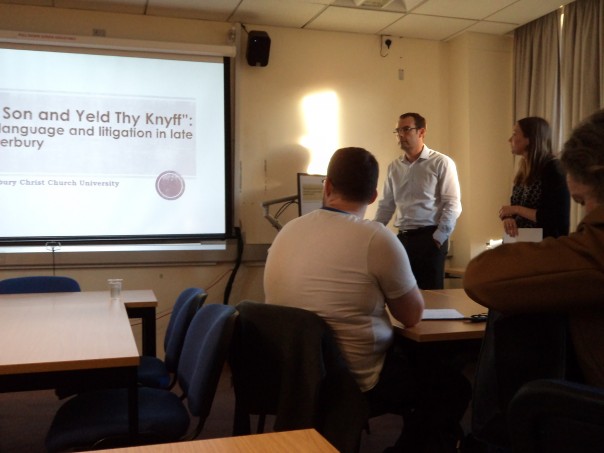Before I get to the main events of the last week, I thought I would mention three events next month that either the Centre is organising/co-organising (with Kent Archaeological Society) or in which Centre staff are involved. In terms of the latter, Dr Martin Watts will be giving two talks as part of the ‘100 Years since Armistice’ event that will be taking place on Friday 9 November. The programme of talks, music and readings will begin with a reception from 10.00 and will conclude by 17.00, participants having a final chance to view the exhibition in the corridor outside Powell Lecture Theatre. If you would like more details, please call 01227 922994. Regarding the former, I am among the speakers at the ‘Exploring Kentish Naming Practices’ all-day conference on Saturday 17 November. As regular readers of the blog may have guessed medieval pigs will feature in my talk! For details of the programme, please refer to the webpage at www.canterbury.ac.uk/kent-names or email artsandculture@canterbury.ac.uk or phone 01227 782994. Tickets are selling very well, so please if this looks interesting, do have a look and book. Then on Tuesday 27 November at the Becket Lecture, Dr Rachel Koopmans (York University, Toronto) will speak on ‘Fake or Fortune? The curious case of Thomas Becket’s pilgrims in Canterbury’s stained glass’ in the Powell Lecture Theatre, Pg09 at 6.30pm – all welcome for what will be a fascinating talk.
Running through the week, on Monday Professor Jackie Eales and I attended a meeting of the Public Engagement Stakeholders group in Canterbury, which as you might guess from the title is intended to bring together the various cultural and heritage organisations in Canterbury and further afield with representatives from the universities. This was the group’s second meeting and this time was chaired by Professor Mike Weed from CCCU. There was some interesting discussion, but perhaps the most useful section was Lisa Carlson’s presentation on the development strategy she and her colleagues at the Canterbury BID have produced after consultation with various interested parties.
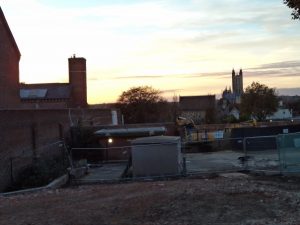
Looking north from close to St Martin’s to St Augustine’s and then the cathedral
Keeping on the theme of heritage, I attended a meeting chaired by Jackie Eales on Tuesday concerning how Canterbury Christ Church and others intend to celebrate Canterbury’s thirty years as a UNESCO World Heritage site – collectively St Martin’s church, St Augustine’s Abbey and Canterbury Cathedral. This is something Mike Butler, formerly of CCCU, is very keen to promote, believing that this is a golden opportunity to bring the three parts together to enhance understanding and appreciation of the global importance of Canterbury’s role and place in the development of Christianity. Indeed, the HLF project on Canterbury as ‘England’s Crucible’ back in 2010 which he led did just that, and it is good to know the booklets produced as part of that project are still available. In 2019, the Centre’s contribution to this celebration will be a weekend conference on the 24 and 25 May. Jackie has already found several international speakers and she is actively filling in the rest of the programme that may include tours led by Canterbury Archaeological Trust and a visit to the cathedral archives, as well as a series of talks. Others from CCCU who may organise complementary events are Dr Jane Lovell (Tourism), Professor Peter Vujakovic (Geography) and Dr Bob Bowie (Education).
Later on Tuesday it was the first of this term’s staff-postgraduate History seminars. These are open to staff, students and the public as part of the university’s knowledge exchange initiative, and on Tuesday it was the turn of Dr David Grummitt (Head of the School of Humanities). David gave an extended presentation of his paper at the Fifteenth Century conference at Reading last month. For those who would like to see a report on this, please see: https://blogs.canterbury.ac.uk/kenthistory/showcasing-medieval-canterbury-more-tv-coverage/
As I said before, the incident at the Rosiers is a fascinating violent culmination of various disputes between the civic authorities and Christ Church Priory (a change from the authorities’ other principal ‘foe’, St Augustine’s Abbey). While David was talking, I was reminded of Rebecca Warren’s MA dissertation from 2010 where she had discussed this and other 15th-century civic-Church disputes and had concluded, as David did, that ‘the civic authorities employed a number of negotiation strategies, many of which were typical of other towns in similar circumstances; the implication is that they were fully aware of conflicts taking place elsewhere.’ Where David and Rebecca differ to a degree is in their reading of the civic authorities’ desire to use the legal processes of the King’s Bench, David seeing the senior officers as more willing to do this because they included several London-trained lawyers among their membership. At times during the 15th century their confidence was well founded, but due to an unforeseen unfortunate set of circumstances this did not quite materialise as the civic authorities had hoped in the early years of the 1500s.
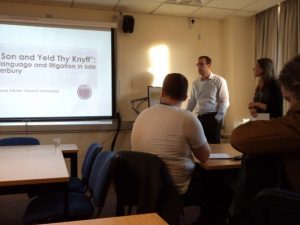
Professor Louise Wilkinson introduces Dr David Grummitt.
David’s paper generated considerable discussion among his interested audience. As well as matters relating to the authorities’ use of the royal law courts, several people were keen to ask whether he saw evidence of the city forming alliances with other religious institutions; what relations were like between the friaries and the city; what relations were like on a personal level between senior civic officers and various abbots and priors, and did he believe such incidents should be seen as evidence of anticlericalism in the city (something proposed by Peter Clark in English Provincial Society from the Reformation to the Revolution, albeit for a slightly later period in Canterbury’s history). Like Rebecca, David pointed out that the wills of the senior city officers of this period are orthodox in their piety and that many included bequests to named monastic and other clerics, as well as to the monasteries as a whole, which suggests that these senior townsmen were perfectly capable of ‘compartmentalising’ such matters. Canterbury is not alone in this and Dr Mark Merry, for example, found this same phenomenon at Bury St Edmunds in the later Middle Ages when he was working on his doctorate. However, David did think the presence of these common lawyers in Canterbury with their London and Kent gentry connections may have meant the city was in some senses more ready and able to embrace the religious/legal changes of the late 1520s and 1530s. He may be right, although I’m not so sure having looked at the ‘promotion’ of the St Thomas Pageant and other civic concerns of the early 16th century, as well as the depositions collected by Cranmer in the early 1540s, which means Rebecca and I are in greater agreement on this point. Nonetheless, it was excellent to hear David’s analysis and like his previous work on rhetoric and the use of language in ‘Deconstructing Cade’s Rebellion: discourse and politics in the mid fifteenth century’ (2006), I shall look forward to seeing this in print.
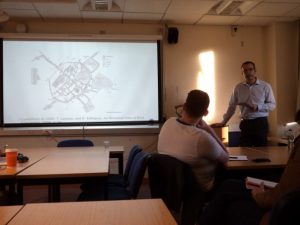
David Grummitt discusses civic-Church relations in 15th-century Canterbury
Moving on to Thursday, it was the second in the Centre and Friends of Canterbury Archaeological Trust autumn lecture series. Like David’s talk, this attracted a good-sized audience of staff, students and members of the public. As Dr John Williams (chairman of FCAT) said in his introduction, it is a very opportune moment to hear Dr Andrew Richardson’s (Canterbury Archaeological Trust) assessment of the excavation finds accumulated by the Trust over more than forty years; and how this great collection can be deployed in the future more effectively for research, teaching, conservation and perhaps ultimately display for a part of the collection (allowing that some is already currently loaned to the city’s museum service for display at The Beaney and Roman Museum). For early next month the Trust’s vast collection (except for that held in Dover) will be moved from Kingsmead and other stores to a newly-adapted, much larger store in the old Adscene and associated buildings in Wincheap. This is a very exciting development and is the brain-child of Professor Paul Bennett (Director of the Trust and Visiting Professor in the Centre).

Andrew Richardson introduces the range of finds held by CAT
Consequently, Andrew started by showing the current state of the Trust’s storage facilities, as well as offering an idea of the scale and diversity of the Trust’s finds collection which is staggering in its size and complexity. Andrew was also keen to highlight that it is not solely the physical finds that matter, but that context is equally important, and thus the vital nature of accurate recording and the photographic record. He was also keen to point out that it is not only the ‘bling’ that is valuable, indeed what may appear at first sight rather mundane can be extremely useful if, for example, it provides evidence of local manufacture or particular trade routes. Equally environmental samples may provide evidence of diet, the health of a population and other vital clues about past communities. Nevertheless, Andrew had picked out several photos of items that he said would be in his ‘top ten’, and he thinks the Trust’s most significant find so far is the Dover Bronze Age boat, not least because of the number of publications, conferences and exhibitions it has generated in Kent and in Belgium and northern France.
In addition to showcasing the breadth and depth of the collection, Andrew was keen to highlight the great work done by Trust staff and volunteers respecting washing, cataloguing and caring for these finds. He also described the process whereby certain assemblages were analysed by specialists outside the Trust, as well as mentioning the team employed directly by CAT, including himself as the small finds expert. As he said, he and the others will benefit from this move because apart from anything else they will be together in the one pleasant building for the first time, which should make working more agreeable and ultimately far more efficient. Thus, Andrew finished on a very upbeat note, and, while he is well aware that there may be teething problems at first, this is an extremely exciting and welcome development which has the potential to transform what might be called the post-excavation part of the Trust’s work.
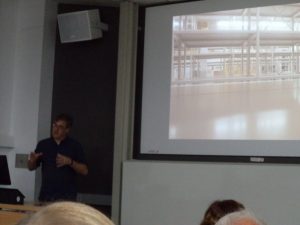
Andrew Richardson shows the new finds store
Finally, I thought I would just mention that last night I gave a short presentation to members of OHSCA (Oaten Hill and South Canterbury Association) and the public after OHSCA’s AGM. This comprised an examination of people and places in late medieval Ridingate Ward. Consequently, we looked at the vastness of this ward, which is not widely known, before turning to look at who lived there and what they did for a living. I also mentioned some of the criminal activities recorded in the local courts, including the medieval form of fly-tipping, and an apparent case of fencing stolen goods that involved among other items two tails – sold on to a skinner living next to St George’s church. However life was not solely work, and we explored leisure pastimes before investigating the relationship between various people and the churches in the ward that had parochial responsibilities – St Mary Bredin, St Sepulchre’s nunnery and St Lawrence’s hospital (St Edmund Ridingate having ceased to function by this time).To finish, I offered those interested the opportunity to look at four wills made by people from the area, including a local widow and Alice Colman of St Lawrence’s hospital. Several people took up the offer and we concluded with a short impromptu palaeography lesson.
 Centre for Kent History and Heritage
Centre for Kent History and Heritage Sheila Sweetinburgh
Sheila Sweetinburgh 1108
1108